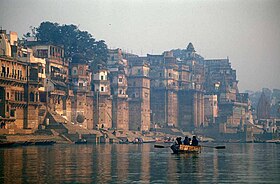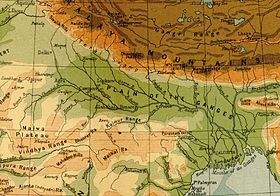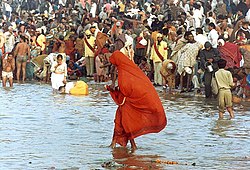Gang
Gang ili Ganga je jedna od najdužih reka Indijskog potkontinenta. Reka izvire u zapadnom delu Himalaja u indijskoj saveznoj državi Utarančal, teče severnim delom Indije, prelazi u Bangladeš, i uliva se u Bengalski zaliv kao delta u području Sundarbans. Gang je treća reka u svetu po količini vode na ušću.
| Gang | |
|---|---|
 Gang u Varanasiju | |
 | |
| Opšte informacije | |
| Dužina | 2.525 km |
| Basen | 1.080.000 km2 |
| Pr. protok | 12 015 m3⁄s |
| Vodotok | |
| Izvor | Utarahand, Indija |
| V. izvora | 3.892 m |
| Ušće | Bengalski zaliv, Bangladeš |
| Geografske karakteristike | |
| Država/e | |
| Pritoke | Varuna River, Tamsa River, Ramganga, Gomti River, Gagra, Gandak, Kosi, Mahananda River, Jamuna, Son, Bhagirathi River, Gandaki River, Padma River, Alaknanda River, Karmanasa River, Sarayu, Yarlung Tsangpo River, Burhi Gandak River, Punpun River, Rāmgangā River |
| Reka na Vikimedijinoj ostavi | |

U hinduizmu, Gang se smatra svetom rekom.[1] Ova reka je takođe izvor života za milione Indijaca koji žive duž njenog toka i zavise o nje za svoje svakodnevne potrebe.[2] Ona se obožava kao boginja „Gang“ u Hinduizmu.[3] Ona je isto tako bila istorijski važna, sa mnoštvom bivših pokrajinskim ili imperijalnim prestonicama (kao što su[4] Kanauž, Kampilja, [4] Kara, Alahabad, Kaši, Patna, Hažipur, Munger, Bagalpur, Muršidabad, Baharampur, Nabadvip, Saptagram, Kolkata i Daka) lociranim na njenim obalama.
Gang je rangiran kao peta najzagađenija reka na svetu 2007. Zagađenje ugrožava ne samo ljude, nego i više od 140 ribljih vrsta, 90 amfibijskih vrsta i ugroženu vrstu indijskog rečnog delfina.[5] Nivoi fekalnih koliformi od ljudskog otpada u vodama reke u blizini Varanasija su više od sto puta veći od zvaničnog limita Indijske vlade.[5] Akcioni plan Ganga, je jedna od inicijativa za zaštitu životne sredine usmerena na čišćenje reke, koja do sad nije bila uspešna,[6] usled korupcije, nedostatka tehničke stručnosti, lošeg planiranja životnog okruženja, i nedostatka podrške lokalnih verskih vlasti.
Geografske karakteristike
urediGang se oblikuje spajanjem pet malih reka na južnim obroncima Himalaja; Bagirati, Alaknanda, Mandakini, Dauliganga i Pindar, u indijskoj državi Utarahand.[7][8] Dva najveće su Alaknanda i Bagirati, Alaknanda izvire 50 km severno od himalajskog vrha Nanda Devi, a Bagirati izvire na 3000 m nadmorske visine, ispod lednika Gangotri kog Hindusi smatraju svetim.[9] Za izvor Ganga se smatra mesto Gaumuk koje leži 21 km jugoistočno od Gangotrija, gde se spajaju Alaknanda i Bagirati, tek odatle se reka zove Gang.
Gang od obronaka Himalaja teče gotovo pravolinijski u smeru jugoistoka prema Bengalskom zalivu. Porečje Ganga pokriva četvrtinu Indije, dela koji je najgušće naseljen u kom živi stotine miliona ljudi. U njemu su se rađale i umirale istorijske civilizacije kao što je Maurijsko carstvo (322. p. n. e.) sve do Mogulskog carstva iz 16. veka.[9] Gang protiče kroz indijsku državu Utar Pradeš gde prima svoju najveću desnu pritoku Jamuna kod Alahabada, tu dobija i tri velike leve pritoke; Ramgangu, Gomti i Gagaru.[9]
Nakon tog reka teče kroz državu Bihar gde prima pritoke sa Himalaje; Gandaki, Buri Gandak, Gugri i Koši i najvažniju južnu pritoku Son. Nakon tog reka teče kroz poslednju indijsku državu Zapadni Bengal, gde prima zadnju indijsku pritoku Mahanandu.[9]
U svom donjem delu, reka teče kroz Bangladeš, tu se spaja sa Bramaputrom i skreće na jug. Zajednička reka se odatle zove Padma, koja kod glavnog grada Bangladeša Dake dobija veliku pritoku Megnu (odatle se reka zove Megna) i počinje formirati najveću deltu na svetu - Delta Ganga, kojom se uliva u Indijski okean preko Bengalskog zaliva.[9]
Deo delte uz more, sa najvećom šumom mangrove na svetu poznatom kao Sundarbans i Indija i Bangladeš proglasili su Nacionalnim parkom, koji je UNESKO uvrstio u Svetsku baštinu, i to 1987. indijski deo, a 1997. i deo koji pripada Bangladešu.[9]
Geologija
urediIndijski potkontinent leži na Indijskoj tektonskoj ploči, manjoj ploči unutar Indo-australijske ploče.[10] Njeni definicioni geološki procesi počeli su pre sedamdeset i pet miliona godina, kada je, kao deo južnog potkontinenta Gondvana, započeo severoistočno pomeranje - tokom pedeset miliona godina - preko tada neformiranog Indijskog okeana.[10] Naknadna kolizija potkontinenta sa Evroazijskom pločom i subdukcija ispod nje, proizveli su izdizanje Himalaja, najvišeg planinskog lanca na planeti.[10] U bivšem morskom dnu neposredno južno od Himalaja, kretanje ploča je kreiralo ogromno korito, koje, nakon što je postepeno napunjeno sedimentima koje je nosile reke Ind i Gang sa njigovim pritokama,[11] sad formira Indo-ganšku niziju.[12]
Indo-ganška nizija je geološki poznata kao pregibna ivica ili pregibni sliv.[13]
Vidi još
urediReference
uredi- ^ Alter, Stephen (2001), Sacred Waters: A Pilgrimage Up the Ganga River to the Source of Hindu Culture, Houghton Mifflin Harcourt Trade & Reference Publishers, ISBN 978-0151005857, Pristupljeno 30. 7. 2013
- ^ „US TV host takes dig at Ganges”. Zeenews.com. 16. 12. 2009. Pristupljeno 4. 7. 2012.
- ^ Bhattacharji & Bandyopadhyay 1995, str. 54
- ^ a b Ghosh 1990.
- ^ a b Rice, Earle (2012), The Ganges River, Mitchell Lane Publishers, Incorporated, str. 25, ISBN 978-1612283685
- ^ "Clean Up Or Perish" Arhivirano na sajtu Wayback Machine (3. novembar 2011), The Times of India, 19 March 2010
- ^ „Ganges River”. Encyclopædia Britannica (Encyclopædia Britannica Online Library izd.). 2011. Pristupljeno 23. 4. 2011.
- ^ Penn 2001, str. 88
- ^ a b v g d đ „Ganges River”. Encyclopædia Britannica (Encyclopædia Britannica Online Library izd.). 2011. Pristupljeno 16. 11. 2015.
- ^ a b v Ali & Aitchison 2005.
- ^ Dikshit & Schwartzberg 2007, str. 7
- ^ Prakash, B.; Kumar, Sudhir; Rao, M. Someshwar; Giri, S. C. (2000). „Holocene tectonic movements and stress field in the western Gangetic plains” (PDF). Current Science. 79 (4): 438—49.
- ^ Dmowska 2003, str. 14
Literatura
uredi- Dmowska, Renata (2003). Advances in Geophysics. Academic Press. str. 14. ISBN 978-0120188468. Pristupljeno 6. 5. 2011.
- Bhattacharji, Sukumari; Bandyopadhyay, Ramananda (1995). Legends of Devi. Orient Blackswan. str. 54. ISBN 978-8125007814. Pristupljeno 27. 4. 2011.
- Abraham, Wolf-Rainer. „Megacities as Sources for Pathogenic Bacteria in Rivers and Their Fate Downstream” (PDF). International Journal of Microbiology. 2011 (798292): 1—13. doi:10.1155/2011/798292.
- Ali, Jason R.; Aitchison, Jonathan C. (2005). „Greater India”. Earth-Science Reviews. 72 (3–4): 169—88. doi:10.1016/j.earscirev.2005.07.005.
- Alley, Kelly D. (2002). On the banks of the Gaṅgā: when wastewater meets a sacred river. University of Michigan Press. ISBN 978-0472068081. Pristupljeno 26. 7. 2011.
- Alter, Stephen (2001). Sacred waters: a pilgrimage up the Ganges River to the source of Hindu culture. Harcourt. ISBN 978-0151005857. Pristupljeno 26. 7. 2011.
- Arnold, Guy (2000). World Strategic Highways (1st izd.). Fitzroy Dearborn. str. 223—27. ISBN 978-1579580988. doi:10.4324/9781315062204.
- Berga, L. (2006). Dams and Reservoirs, Societies and Environment in the 21st Century. Proceedings of the International Symposium on Dams in the Societies of the 21st Century, 22nd International Congress on Large Dams (ICOLD). Barcelona, Spain: Taylor & Francis. ISBN 978-0415404235.
- Bharati, Radha Kant (2006). Interlinking of Indian rivers. Lotus. ISBN 978-8183820417.
- Blurton, T. Richard (1993). Hindu art. Harvard University Press. ISBN 978-0674391895. Pristupljeno 26. 7. 2011.
- Brichieri-Colombi, Stephen; Bradnock, Robert W. (2003). „Geopolitics, water and development in South Asia: cooperative development in the Ganges–Brahmaputra delta”. The Geographical Journal. 169 (1): 43—64. doi:10.1111/1475-4959.t01-1-00002.
- Brune, James N. (1993). „The seismic hazard at Tehri dam”. Tectonophysics. Elsevier. 218 (1–3): 281—86. doi:10.1016/0040-1951(93)90274-N.
- Caso, Frank; Wolf, Aaron T. (2010). Freshwater Supply Global Issues. Infobase. ISBN 978-0816078264.
- Chakrabarti, Dilip K. (2001). „4 The Archaeology of West Bengal: The Bhagirathi Mouth and the Midnapur Coast”. Archaeological Geography of the Ganga Plain: The Lower and the Middle Ganga. Permanent Black. ISBN 978-8178240169.
- Darian, Steven G. (2001). The Ganges in myth and history. Motilal Banarsidass. ISBN 978-8120817579. Pristupljeno 26. 7. 2011.
- Dhungel, Dwarika Nath; Pun, Santa B. (2009). The Nepal-India Water Relationship: Challenges. Springer. ISBN 978-1402084027. Pristupljeno 27. 4. 2011.
- Dikshit, K.R.; Schwartzberg, Joseph E. (2007), „India: The Land”, Encyclopædia Britannica, str. 1—29
- Dudgeon, David (2005). „River Rehabilitation for Conservation of Fish Biodiversity in Monsoonal Asia” (PDF). Ecology and Society. 10 (2:15).
- Eck, Diana L. (1982). Banaras, city of light. Columbia University. ISBN 978-0231114479. Pristupljeno 26. 7. 2011.
- Eck, Diana (1998). „Gangā: The Goddess Ganges in Hindu Sacred Geography”. Ur.: Hawley, John Stratton; Wulff, Donna Marie. Devī: Goddesses of India. University of California / Motilal Banarasidass. str. 137—53. ISBN 978-81-208-1491-2.
- Elhance, Arun P. (1999). Hydropolitics in the Third World: Conflict and Cooperation in International River Basins. United States Institute of Peace. ISBN 978-1878379900.
- Gardner, Gary (2003). „Engaging Religion in the Quest for a Sustainable World”. Ur.: Bright, Chris; et al. State of the World: 2003 (Special 20th anniversary izd.). Norton. str. 152-76. ISBN 978-0393323863.
- Ghosh, A. (1990). An Encyclopaedia of Indian Archaeology. Brill. str. 334. ISBN 978-9004092648.
- Gupta, Avijit (2007). Large rivers: geomorphology and management. Wiley. ISBN 978-0-470-84987-3. Pristupljeno 23. 4. 2011.
- Haberman, David L. (2006). River of Love in an Age of Pollution: The Yamuna River of Northern India. University of California. ISBN 978-0520247901.
- Hill, Christopher V. „3 The Mauryan Empire and the Classical Age – Irrigation in Early India”. South Asia: an environmental history. str. 32. ISBN 978-1851099252.
- Hillary, Sir Edmund (1980). From the ocean to the sky. Ulverscroft. ISBN 978-0708905876. Pristupljeno 26. 7. 2011.
- Jain, Sharad K.; Agarwal, Pushpendra K.; Singh, Vijay P. (2007). Hydrology and water resources of India. Springer. ISBN 978-1402051791.
- Krishna Murti, C. R. (1991). The Ganga, a scientific study. Gaṅgā Pariyojanā Nideśālaya; India Environment Research Committee. Northern Book Centre. ISBN 978-8172110215.
- Kumar, Rakesh; Singh, R. D.; Sharma, K. D. (10. 9. 2005). „Water Resources of India” (PDF). Current Science. Bangalore: Current Science Association. 89 (5): 794—811. Arhivirano (PDF) iz originala 14. 10. 2013. g. Pristupljeno 13. 10. 2013.
- Los Angeles County Museum of Art; Pal, Pratapaditya (1988). Indian Sculpture: 700–1800. University of California Press. ISBN 978-0520064775. Pristupljeno 26. 7. 2011.
- Maclean, Kama (2008). Pilgrimage and power: the Kumbh Mela in Allahabad, 1765–1954. Oxford University Press US. ISBN 978-0195338942. Pristupljeno 27. 7. 2011.
- Markandya, Anil; Murty, Maddipati Narasimha (2000). Cleaning-up the Ganges: a cost-benefit analysis of the Ganga Action Plan. Oxford University Press. ISBN 978-0195649451. Pristupljeno 29. 7. 2011.
- Mirza, M. Monirul Qader (2004). The Ganges water diversion: environmental effects and implications. Dordecht: Springer. str. 1—6. ISBN 978-9048166657. doi:10.1007/978-1-4020-2792-5.
- Newby, Eric (1998). Slowly down the Ganges. Lonely Planet. ISBN 978-0864426314. Pristupljeno 26. 7. 2011.
- Pal, Pratapaditya (1997). Divine images, human visions: the Max Tanenbaum collection of South Asian and Himalayan art in the National Gallery of Canada. National Gallery of Canada. ISBN 978-1896209050. Pristupljeno 27. 7. 2011.
- Parua, Pranab Kumar (2009), „14 Necessity of Regional Co-operation”, The Ganga: water use in the Indian subcontinent, Springer, str. 267—72, ISBN 978-9048131020
- Prakash, Gyan (1999). „6 Technologies of Government”. Another Reason: Science and the Imagination of Modern India. ISBN 978-0691004532.
- Puttick, Elizabeth (2008). „Mother Ganges, India's Sacred River”. Ur.: Emoto, Masaru. The Healing Power of Water. Hay House. str. 241—52. ISBN 978-1401908775.
- Rahaman, M.M. (2009), „Integrated Ganges Basin Management: conflicts and hope for regional development”, Water Policy, 11 (2): 168—90, doi:10.2166/wp.2009.012, Arhivirano iz originala 27. 9. 2011. g., Pristupljeno 5. 9. 2017
- Rahaman, M.M. (2009), „Principles of transboundary water resources management and Ganges Treaties: An Analysis”, International Journal of Water Resources Development, 25 (1): 159—73, doi:10.1080/07900620802517574
- Rodda, John C.; Ubertini, Lucio (2004). „The Basis of Civilization: Water Science?”. IAHS publication no. 286. Wallingford, Oxfordshire, UK: International Association of Hydrological Sciences, IAHS International Commission on Water Resources Systems: 165. ISBN 978-1901502572.
- Sack DA, Sack RB, Nair GB, Siddique AK (2004), „Cholera”, Lancet, 363 (9404): 223—33, PMID 14738797, doi:10.1016/S0140-6736(03)15328-7
- Salman, Salman M. A.; Uprety, Kishor (2002). Conflict and cooperation on South Asia's international rivers: a legal perspective (PDF). World Bank Publications. ISBN 978-0821353523. Pristupljeno 27. 4. 2011.
- Sharma, Ramesh C.; Bahuguna, Manju; Chauhan, Punam (2008). „Periphytonic diversity in Bhagirathi:Preimpoundment study of Tehri dam reservoir”. Journal of Environmental Science and Engineering. 50 (4): 255—62. PMID 19697759.
- Sheth, Jagdish N. (2008). Chindia Rising. Tata McGraw-Hill. ISBN 978-0070657083.
- Singh, Munendra; Singh, Amit K. (2007), „Bibliography of Environmental Studies in Natural Characteristics and Anthropogenic Influences on the Ganga River”, Environ Monit Assess, 129: 421—32, doi:10.1007/s10661-006-9374-7
- Singh, Nirmal T. (2005). Irrigation and soil salinity in the Indian subcontinent: past and present. Bethlehem, PA: Lehigh University. ISBN 978-0934223782.
- Stone, Ian (2002). Canal Irrigation in British India: Perspectives on Technological Change in a Peasant Economy. CUP. ISBN 978-0521526630. Pristupljeno 26. 7. 2011.
- Suvedī, Sūryaprasāda (2005). International watercourses law for the 21st century: the case of the river Ganges basin. Ashgate. ISBN 978-0754645276.
- Thapar, Romila (oktobar 1971). „The Image of the Barbarian in Early India”. Comparative Studies in Society and History. CUP. 13 (4): 408—36. JSTOR 178208. doi:10.1017/s0010417500006393.
- Tiwari, R. C. (2008). „Environmental Scenario in India”. Ur.: Dutt, Ashok K. Explorations in Applied Geography. PHI Learning. ISBN 978-81-203-3384-0.
- Wangu, Madhu Bazaz (2003). Images of Indian goddesses: myths, meanings, and models. Abhinav Publications. ISBN 978-8170174165. Pristupljeno 26. 7. 2011.
- Wink, André (2002). „From the Mediterranean to the Indian Ocean: Medieval History in Geographic Perspective”. Comparative Studies in Society and History. 44 (3): 416—45. JSTOR 3879375. doi:10.1017/s001041750200021x.
- Berwick, Dennison. A Walk Along the Ganges. Dennison Berwick. ISBN 978-0713719680.
- Cautley, Proby Thomas (1864). Ganges canal. A disquisition on the heads of the Ganges of Jumna canals, North-western Provinces. London, Printed for Private circulation.
- Fraser, James Baillie (1820). Journal of a tour through part of the snowy range of the Himala Mountains, and to the sources of the rivers Jumna and Ganges. Rodwell and Martin, London.
- Hamilton, Francis (1822). An account of the fishes found in the river Ganges and its branches. A. Constable and company, Edinburgh.
- Singh, Indra Bir (1996), „Geological Evolution of the Ganga Plain”, Journal of the Palaentological Society of India, 41: 99—137
Spoljašnje veze
uredi- Ganges River na portalu Encyclopædia Britannica
- On Thinner Ice 如履薄冰: signs of trouble from the Water Tower of Asia, where headwaters feed into all the great rivers of Asia (by GRIP, Asia Society and MediaStorm)
- Ganga in the Imperial Gazetteer of India, 1909
- Melting Glaciers Threaten Ganga
- Bibliography on Water Resources and International Law
- Ganga Ma: A Pilgrimage to the Source na sajtu YouTube
- An article about the land and the people of the Ganga
- The impacts of water infrastructure and climate change on the hydrology of the Upper Ganga River Basin
- Bahar Dutt, "Saving the Ganges" на сајту YouTube CNN–IBN Live 5 May 2012.
- The Ganges: A Journey into India
- It’s scientifically validated now; Ganga water is ‘holy’!